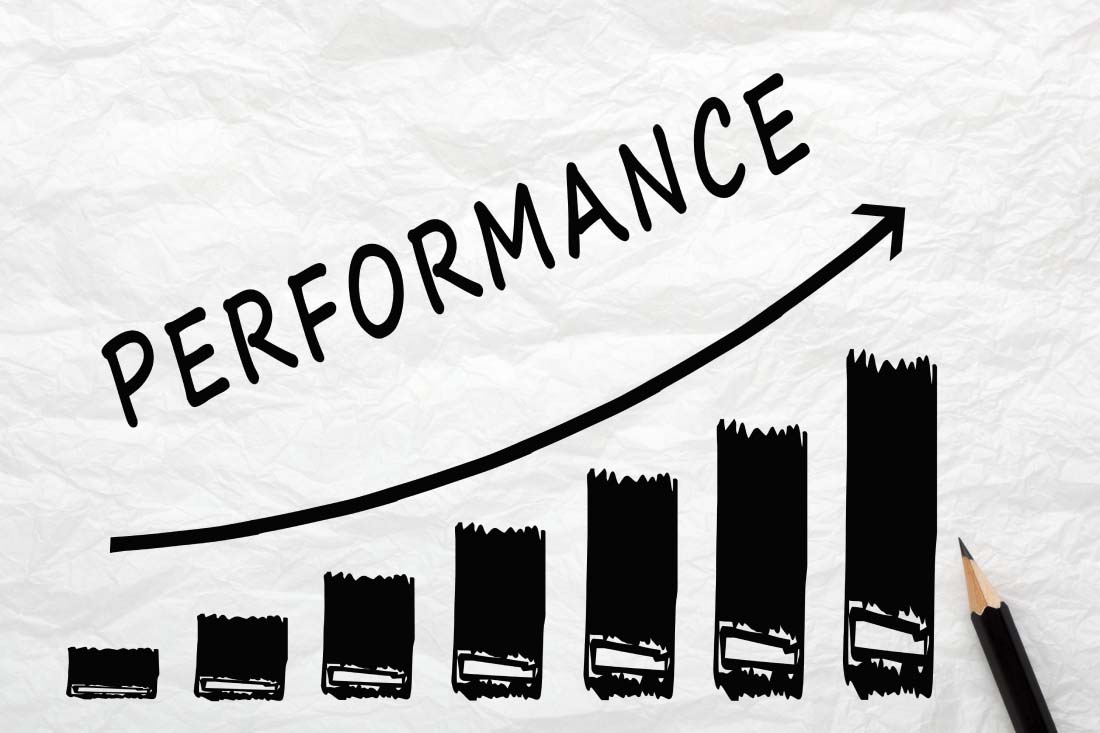To stay competitive, organizations must focus on improving work performance to enhance productivity and achieve higher levels of success. This list will explore various strategies executives leverage to optimize workforce performance, including the significance of performance metrics and implementing sound practices.
The importance of good work performance
Employee effectiveness directly influences a business’s overall success. High work performance leads to more productivity, better customer satisfaction and increased revenue — and contributes to company morale, job satisfaction and employee longevity. That’s because employees who perform well feel better about themselves and their work, which makes them want to contribute more to the organization and stay in their jobs longer. High-performing workforces feed into a cycle of even better performance for the entire organization.
High performance also resonates with your customer base. When customers are satisfied with your products or services, they’re more likely to continue using them. They’re also more likely to recommend them to others or provide good reviews of your organization to improve your reputation.
Organizations with high-performing cultures also have an easier time recruiting top talent and reducing turnover. Job seekers want to work in an organization where they can perform their best and be part of a high-performing team.
Different measures of work performance
There are many different ways to measure employee performance depending on your industry and the nature of your workforce. The most basic measurements are:
- Task completion: How quickly is work finished? Is it completed by a deadline?
- Goal achievement: How often do employees and departments hit goals?
- Productivity: How much quality work are employees completing in a given timeframe?
- Work quality: How often does work need to be redone? How satisfied are customers?
- Well-being: Do employees maintain a healthy work-life balance? Are they burned out?
- Employee engagement: How engaged are employees? Are they connected to their work?
- Emotional intelligence: How effective are employees at working together and communicating effectively? Do teams effectively resolve conflict?
- Adaptability: How quickly do employees adopt new tools, technology or policies? How willing is leadership to change tactics when old ones aren’t working?
Some measures are easier to track than others. Task completion is as simple as marking a task “done.” But productivity and goal achievement require more insight. Tools like ActivTrak’s workforce analytics solution provide deeper insight and real data into productivity, employee well-being and employee engagement. Leaders easily see how changes affect the workplace to make data-driven decisions on what to do next.
Key factors that affect work performance
Many factors affect work performance, most of them directly influenced by management decisions. Here are some of the most common:
- Low motivation or employee engagement
- Lack of communication
- Unclear priorities
- Overwork and stress
- Lack of clear goals or job roles
- Poor work environment
- Lack of opportunities and development
- Limited feedback
- The wrong tools or technology
- Improper equipment
- Lack of training
- Distractions or unnecessary meetings
- Micromanagement or feelings of mistrust
- Lack of recognition or rewards
- Misalignment with company goals or priorities
- Disengagement
- Personal issues
Top ways to improve work performance in your business
1. Focus on goal-setting
Many organizations make the mistake of setting goals without digging into how teams will accomplish them, what they mean or how to communicate them. Leadership should set achievable goals that are SMART – specific, measurable, achievable, relevant and time-bound.
2. Track goals
To stay on track, teams must monitor goals effectively. Beyond completing tasks on time, employees need to understand how their work contributes to an organization’s strategic goals and have visibility into everyone’s progress. Tools like ActivTrak give actionable data on goals and progress, including trends to inform next steps.
3. Communicate clearly
Effective communication is the basis of any high-performing organization. Unfortunately, according to recent research, 80% of employees say their organizations’ communication is poor or average. Focus on finding the right way to communicate with your teams, including organizational policies, strategic goals and any changes that are on the horizon.
4. Prioritize effectively
If everything is important, nothing is important. When employees have too many looming deadlines, they’re likely to get overwhelmed and lose motivation. Prioritize tasks and projects based on their alignment with your organizational strategy and make sure all team members understand what matters.
5. Encourage effective time management
Employees must manage their time effectively to achieve goals, meet deadlines and complete tasks. Empower team members with effective time management skills so they can focus on tasks and avoid stress or burnout.
6. Give timely feedback
Telling employees how they’re doing is important. Constructive criticism and timely feedback allow for continuous learning and improvement while ensuring goals are aligned. It also provides managers a chance to communicate more effectively with employees to ensure everyone is performing at their best.
7. Learn to delegate with trust
Micromanagement destroys employee morale and overall performance. Leaders must learn to delegate with trust and confidence to let employees work autonomously and effectively. Comprehensive feedback, goal tracking and communication are good ways to reduce a manager’s need to micromanage.
8. Discourage multitasking
Multitasking causes real problems in performance and hurts productivity. Research shows that switching from one task to another decreases productivity by up to 40%. Encourage employees to focus on one task at a time.
9. Reduce distractions
Distractions also impact performance at work. Research shows it takes people an average of 23 minutes to get back on track after they’re interrupted. Reduce distractions in your organization wherever you can, whether it’s by providing noise-canceling headphones or allowing employees to set focus time and turn off digital notifications.
10. Ensure meetings are necessary
More and more research shows unnecessary meetings are one of the biggest distractions for employees and leaders alike. Eliminate nonessential meetings by creating clear policies on when and why people can set them. Encourage meeting-owners to provide a clear agenda and empower employees to turn down meetings if they need to.
11. Automate and streamline
Research shows employees spend over half their workdays doing “work about work.” Tasks like sending reminder emails, preparing for meetings, time tracking or HR paperwork take up valuable time employees could spend on more meaningful work. Streamline policies and procedures and automate as much as possible to free employees to do what you hired them for.
12. Empower collaboration
Every team is different, but collaboration is almost universally key to getting work done. Provide employees with tools to collaborate effectively, including communication, project management and file sharing capabilities. This includes determining if employees need to work together in an office or if they are better suited to a hybrid or remote set-up. Using ActivTrak productivity monitoring software shows executives when, where and how employees are most productive to empower effective decisions around collaboration and remote work policies.
13. Find the right technology and tools
Effective technology leads to improved productivity, while the wrong technology can throw a wrench in workflows. Ensure team members have the technology and tools they need to complete their work, from collaboration and project management to communication and productivity.
14. Provide high-quality office equipment
Many people don’t realize how much their chair, keyboard or monitor setup affects productivity. Research shows ergonomic equipment empowers employees to work faster with fewer mistakes. Whether your employees work from home or in the office, ensure their equipment is comfortable and supports healthy posture and performance.
15. Give ample training
If your employees don’t understand job roles and technology, they can’t perform well. Ensure team members get ample training on how to do their jobs and use the tools you provide.
16. Offer development opportunities
Training and development do more than improve your employees’ skills and knowledge. Employees are increasingly asking for development opportunities, and organizations that heed this call see lower turnover rates and better performance. Offering meaningful skills programs and professional development opportunities also helps employees feel their jobs have a purpose. Plus, it’s a great way to help underutilized employees find their stride.
17. Recognize and reward achievements
Letting employees know you appreciate their work goes a long way in encouraging high performance. It also fosters morale and a culture of support. Celebrating milestones like work anniversaries or birthdays is also a good way to embed recognition in your workplace.
18. Encourage camaraderie and trust
Human beings need to trust each other to work well together. While not everyone in the workplace needs to be best friends, they should understand each other and be able to resolve conflict effectively. Encourage social activities and team building to build camaraderie. Offering training in personnel differences or strength coaching also helps employees learn to trust each other and work well together.
19. Cross-pollinate among teams
It’s easy for workers to get siloed in their departments or teams as they focus on daily tasks. But encouraging team members to work together across departmental boundaries increases collaboration, innovation and trust.
20. Empower wellness
Employee well-being has become a central aspect of good organizational culture today, and with good reason. Employees who have poor mental or physical health call out more, can’t focus on their work and underperform. Empower wellness by providing employees with good health benefits and tools to create work-life balance.
21. Offer flexibility
More and more employees say they want flexibility at work. Organizations that offer some form of flexibility, whether it’s hybrid work, remote offerings or varied schedules, get seven times as many applicants as those that don’t. Offering flexible work arrangements increases employee engagement, job satisfaction and, in turn, performance.
22. Encourage rest
High-performing teams recognize the importance of rest in improving performance and increasing productivity. Encourage team members to take short breaks throughout the day and to use their paid time off to reset and recharge.
23. Create mentorship opportunities
Employees learn a lot from each other, and mentoring gives people the chance to heighten their skills and develop deeper relationships. Research shows many benefits of mentoring programs, including increased confidence, better employee networks, more trust among employees and increased innovation across the organization. Keep reverse mentorship – where younger employees work with older employees – in mind as a tool to increase understanding across generational divides and help more seasoned team members work with new technology or trends.
24. Listen to employees
According to The Workforce Institute, organizations perform 88% better when their employees feel listened to. This means more than just tossing around an anonymous feedback survey once in a while – it means implementing suggestions and responding to requests. Even if you can’t give employees exactly what they ask for, be willing to explain why or offer alternatives.
25. Adapt and improve
The only constant is change. Your workforce, technology and best practices will change over time. While it’s important to set clear goals and create a good strategy, recognize that you have to adapt to see results in performance. Leverage data to understand trends and prepare in advance for changes with predictive analytics.
Looking for ways to improve work performance in your business?
Building a supportive environment is key to improving work performance. Addressing work performance through targeted strategies is imperative for organizational success, and accurately assessing it cultivates a high-performance culture.
Get the insights and tools you need to boost performance, enhance employee well-being and optimize your workforce outcomes with ActivTrak. Find out what’s holding your employees back and what enhances their performance with real-time data. Get insights into productivity trends across your organization to make informed decisions on technology and workflows. Share insights with managers and employees without compromising data or security.
Whether you’re managing a hybrid or remote team, looking to improve engagement or streamline processes, ActivTrak has a solution tailored to your organization’s needs. Contact our sales team today to discover how we can help you unlock your organization's full potential.


